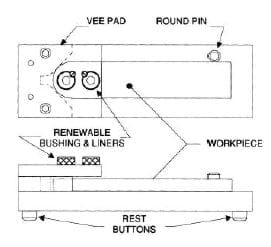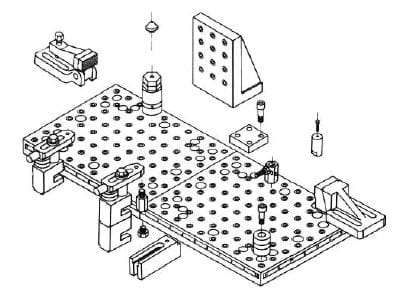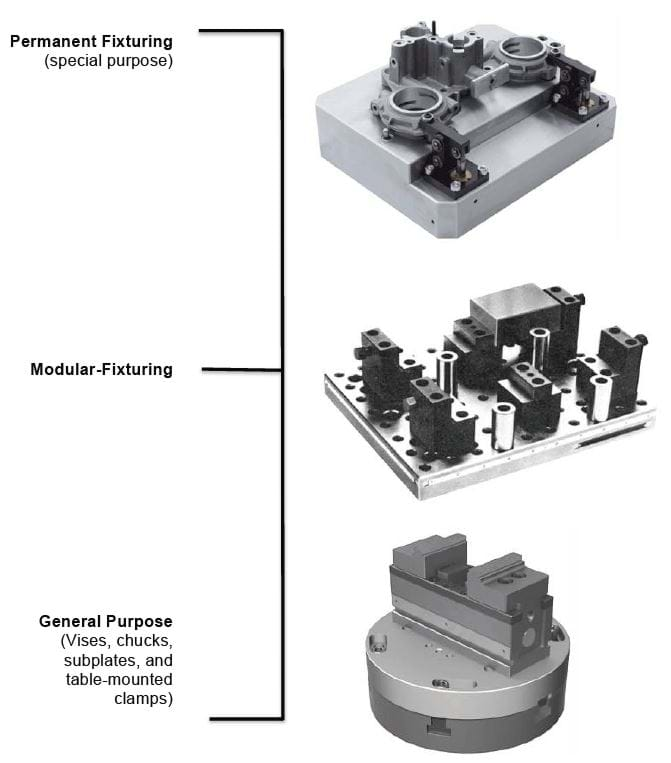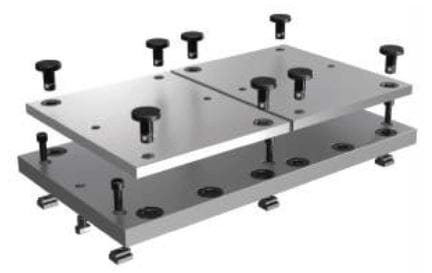Jigs and fixtures are most often found where parts are produced in large quantities, or produced to complex specifications for a moderate quantity. With the same design principles and logic, workholding devices can be adapted for limited-production applications. The major difference between the various types of workholders, from permanent, to flexible, to modular and general-purpose workholders is the cost/benefit relationship between the workholder and the process. Some applications require jigs and fixtures solely for speed; others require less speed and higher precision. The requirements of the application have a direct impact on the type of the jig or fixture built and, consequently, the cost.
Permanent Jigs and Fixtures
Workholders for high-volume production are usually permanent tools. These permanent jigs and fixtures are most often intended for a single operation on one particular part. The increased complexity of permanent workholders yields benefits in improved productivity and reduced operator decision-making, which result in the tool having a lower average cost per unit or per run. Therefore, more time and money can be justified for these workholders.
In the case of hydraulic or pneumatic fixtures, inherent design advantages can dramatically improve productivity and hence, reduce per-unit costs even further, even though the initial cost to construct these fixtures is the most expensive of all fixture alternatives. In some cases, where machine-loading considerations are paramount, such as a pallet-changing machining center, even duplicate permanent fixtures may be justified.

Figure 1-3. A permanent workholder used for a drilling operation.
Permanent jigs and fixtures are typically constructed from standard tooling components and custom-made parts. Figure 1-3 shows a typical permanent workholder for a drilling operation.
Low-volume runs and ones with fewer critical dimensions are often produced with throwaway jigs and fixtures. These tools would typically be one-time-use items constructed from basic materials at hand and discarded after production is complete. Although throwaway jigs and fixtures are technically permanent workholders, in effect they are actually temporary.
General-Purpose Workholders
In many instances, the shape of the part and the machining to be performed allow for the use of a general-purpose workholder such as a vise, collet, or chuck. These workholders are adaptable to different machines and many different parts.
Since they are not part-specific, their versatility allows for repeated use on a variety of different or limited-production runs. The cost of these workholders would usually be averaged over years and might not even be a factor in job-cost calculations. The general-purpose nature of these workholders necessitates a higher level of operator care and attention to maintain consistency and accuracy. For these reasons, general-purpose workholders are not preferred for lengthy production runs.
Modular Fixtures
Modular fixtures achieve many of the advantages of a permanent tool using only a temporary setup. Depicted in Figure 1-4, these workholders combine ideas and elements of permanent and general-purpose workholding.

Figure 1-4. Modular workholders combine ideas and elements of both permanent and temporary workholding to make inexpensive-yet-durable workholders.
The primary advantage of modular fixtures is that a tool with the benefits of permanent tooling (setup reduction, durability, productivity improvements, repeat-ability, and reduced operator decision-making) can be built from a set of standard components. The fixture can be disassembled when the run is complete, to allow the reuse of the components in a different fixture. At a later time the original can be readily reconstructed from drawings, instructions, and photographic records. This reuse enables the construction of a complex, high-precision tool without requiring the corresponding dedication of the fixture components.
Figure 1-5 shows how a modular fixture fits into the hierarchy of workholding options, ranking below permanent fixturing yet above general-purpose workholders. Virtually every manufacturer has suitable applications for each of these three options at one time or another.

Figure 1-5. The hierarchy of workholding options.
Quick-Change Workholders
Recent innovations have incorporated aspects of both permanent and temporary workholders, such as Carr Lock© quick-change workholders. The basis of a Carr Lock© Quick-Change System (Figure 1-6) is a subplate attached to the worktable of the machine with T-Nuts and Socket Head Cap Screws, located by Fixture Keys. This subplate contains a number of receiver bushings to which a variety of fixtures mounted on fixture plates can be attached, using the Carr Lock© clamps. The Carr Lock© System allows accurately locating and clamping at the same time, with just the turn of a hex wrench. Each mount consists of three components: (1) a Carr Lock© Clamp with a precisely ground shank; (2) a Liner Bushing in the top plate; (3) a Receiver Bushing in the subplate.

Figure 1-6. A Carr Lock© Quick-Change System allows accurate locating and clamping at the same time, with just the turn of a wrench for mounting quick-change tooling on a subplate.
Permanent fixtures and modular fixtures can be built on the interchangeable fixture plates, providing the quick-change benefits of temporary fixtures, with all of the benefits of a permanent workholder. Since the fixture location is known, virtually all of the work or referencing the tool to the fixture is predefined. This information can be maintained in the machine program, or on the setup sheet for the job. Changing fixtures is as simple as removing the clamps, then the fixture, placing the next fixture on the subplate and tightening the clamps. Jig-saw plates are available for the mounting of general-purpose workholders, such as vises. Their interlocking design allows a high density of vises on a subplate, the flexibility of a vise, and the precise location of the Carr Lock© System. This feature enables change over approaching one minute, much faster than other methods of changing from one fixture to another. This allows more machining time to be realized each shift.
With the advent of horizontal and five-axis machining centers, exciting new possibilities have presented themselves. Most fixture work on horizontal machines is accomplished from a base of a tooling block or "tombstone." Utilizing a premade aluminum tooling column with Carr Lock© receiver bushings bring quick change capability to these machines. Carr Lock© Modular Fixture Plates are identical to blank Carr Lock© Fixture Plates, except with added multipurpose mounting holes in a standard 2.0000" grid pattern. Every multipurpose hole has a .5000" precision alignment bushing on top, with a 1/2-13 thread below it. Multipurpose holes accept Locating Screws (with a ground locating diameter), Socket Head Cap Screws, clamping studs, and many other threaded components.
Next Topic:
Workholding Considerations
Back to Jig & Fixture Design Information
This page contains information originally published in the Jig & Fixture Handbook, 3rd Edition, Copyright 2016, Carr Lane Manufacturing Co., St. Louis, Mo.